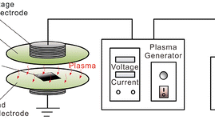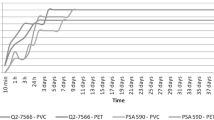Abstract
In this work, plasma and surface coating technologies were combined and used in the modification of room-temperature-vulcanisated silicone rubber (RTV), and their properties were characterised and compared. First, the surface of pure RTV was cured by different plasmas to improve its roughness and hydrophilicity. The plasmas used was nitrogen, oxygen, and atmosphere plasmas. Then, a type of silicone coating, SC, was sprayed on the surface of this plasma treated RTV, and different RTV composites were prepared. The thermal dimensional stability, tensile properties, thermal stability, and acid and alkali resistance of these RTV composites were measured. Results showed the thermal dimensional stability parameters, COLE and COVE, of RTV/SC/P–O2 were much lower compared to neat RTV. Meantime, their tensile properties together with acid and alkali resistance were improved. However, their initial thermal stability was decreased. These RTV composites were also characterised by contact angle test, scanning electron microscope observation, Fourier transform infrared spectroscopy, and X-ray photoelectron spectroscopy.










Similar content being viewed by others
References
Li Y, Hu XS, Lin XD (2010) Study on reinforcement properties of additive RTV organosilicon filling adhesive with MQ resin. Chin Adhesive 19(11):36–39. https://doi.org/10.3969/j.issn.1004-2849.2010.11.009
Zhou NN (2000) Introduction to silicone polymer. Science Press, Beijing
Lai GQ, Xing SM (2009) Synthetic technics and application of silicones. Chemical Industry Press, Beijing
Lee SC, Kim KT (2008) A densification model for powder materials under cold isostatic pressing-effect of adhesion and friction of rubber moulds. Mater Sci Eng A 498(1):359–368. https://doi.org/10.1016/j.msea.2008.08.020
Wang M (2005) Preparation and application of room-temperature vulcanizated silicone rubber. Spec Rubber Prod 26(1):34–35. https://doi.org/10.3969/j.issn.1005-4030.2005.01.012
Wu JC, You CJ, Zeng YZ, Jia DM (2010) Structure and properties of epoxy glue rapid tooling. In: Low-carbon technologies and materials industry development symposium, pp 693–698
Wang JH, Wu JM, Liu YQ, Wang JC (2015) Research on the application properties of TPE/OMMT as mold materials. Progress Rubber Plast Recycl Technol 31(3):157–171. https://doi.org/10.1177/147776061503100302
Yang SY, Wang JC, Wang JH (2017) Study on the application properties of WPU and OMMT in RTV mold rubber. Progress Rubber Plast Recycl Technol 33(3):153–170. https://doi.org/10.1177/147776061703300303
Yang SY, Wang JC, Wang JH (2016) Investigation on the application properties of epoxy resin and glass fiber in RTV mold rubber. Polymers 16(6):437–445. https://doi.org/10.1515/epoly-2016-0188
Ping YU, Zheng GP, Zhang YC (2013) The research progress of thermoplastic/montmorillonite composite materials. Anhui Chem Ind 39(1):16–18, 25. https://doi.org/10.3969/j.issn.1008-553x.2013.01.002
Ding XJ, Chu WJ, Zhang DQ, Yuan Y, Zhang LJ, Han HJ (2010) Research progress on blending modification of thermoplastic polyurethane elastomer (TPU). Chin Elastom 20(2):67–69, 76. https://doi.org/10.3969/j.issn.1005-3174.2010.02.017
Abdoosa M, Yamamotob K, Bosea B, Fox-Rabinovicha G, Veldhuisa S (2019) Effect of coating thickness on the tool wear performance of low stress TiAlN PVD coating during turning of compacted graphite iron (CGI). Wear 422–423(2019):128–136. https://doi.org/10.1016/j.wear.2019.01.062
Bodas D, Rauch JY, Khan-Malek C (2008) Surface modification and aging studies of addition-curing silicone rubbers by oxygen plasma. Eur Polym J 44(7):2130–2139. https://doi.org/10.1016/j.eurpolymj.2008.04.012
Zhuang C, Li Z (2016) Mechanical characterisation of Si–C–N thin films prepared by electron cyclotron resonance plasma chemical vapour deposition at low microwave power and low temperature. Surf Eng 32(11):1–8. https://doi.org/10.1080/02670844.2016.1193274
Chen XD, Pu DX, Sun RH, Hu YJ, Wang JQ (2000) Plasma surface hydrophilic modification of silicone rubber. Polym Mater Sci Eng 16(1):153–155. https://doi.org/10.3321/j.issn:1000-7555.2000.01.046
Xia RJ, Xu X, Luo L, Li LL, Chen H (2013) Biocompatiblity of IOL materials treated by oxygen plasma. Chin Tissue Eng Res 17(21):3914–3920
Goiato MC, Haddad MF, Sinhoreti MAC, Santos DMD, Pesqueira AA, Moreno A (2010) Influence of opacifiers on dimensional stability and detail reproduction of maxillofacial silicone elastomer. Biomed Eng Online 9(1):1–9. https://doi.org/10.1186/1475-925X-9-85
Tripathi D, Dey TK (2013) Thermal conductivity, coefficient of linear thermal expansion and mechanical properties of LDPE/Ni composites. Indian J Phys 87(5):435–445. https://doi.org/10.1007/s12648-013-0256-x
Song MH, Wu GH, Chen GQ, Yang WS (2010) Thermal expansion and dimensional stability of unidirectional and orthogonal fabric M40/AZ91D Composites. Trans Nonferrous Met Soc Chin 20(1):47–53. https://doi.org/10.1016/S1003-6326(09)60095-9
Huang YG, Chen M, Li CM, Tian JW (2004) Application of low temperature plasma technology in surface modification of biomaterials. Mater Rev 18(2):72–74. https://doi.org/10.3321/j.issn:1005-023X.2004.02.021
Huang WR (2009) Liquid Silicone Rubber. Sichuan Science and Technology Press, Sichuan
Tan ALK, Soutar AM (2008) Hybrid sol-gel coatings for corrosion protection of copper. Thin Solid Films 516(16):5706–5709. https://doi.org/10.1016/j.tsf.2007.07.066
Ortiz-Magán AB, Pastor-Blas MM, Ferrándiz-Gómez TP, Morant-Zacarés C, Martín-Martínez JM (2001) Surface modifications produced by N2 and O2 RF plasma treatment on a synthetic vulcanized styrene-butadiene rubber. Plasma Polym 6(1):81–105. https://doi.org/10.1023/a:1011352903775
Gao SH, Zhou KX, Wen LS (2009) Improvement of surface hydrophobicity on silicone rubber modified by CF4 radio frequency capacitively coupled plasma. J Cent S Univ Technol 16(3):365–370. https://doi.org/10.1007/s11771-009-0062-y
Cho DL, Cai HH (2001) Surface modification of silicone rubber by low temperature plasma. Trop Agric Eng 2:32–34
Zhang CS, Ma YZ, Lei WH, Nie FD, He ZL (2004) Study on foam rubber surface by plasma polymeric modification. Silicone Mater 18(3):6–9. https://doi.org/10.3969/j.issn.1009-4369.2004.03.002
Gao SH, Zhou KS, Lei MK, Wen LS (2008) Surface modification of silicone rubber by CF4 radio frequency plasma immersion. Plasma Chem Plasma Process 28(6):715–728. https://doi.org/10.1007/s11090-008-9156-9
Acknowledgements
This work was financially supported by “National Natural Science Funds (No. 51873103)”, “Capacity Building Project of Some Local Colleges and Universities in Shanghai (No. 17030501200)”, “Scientific and Technological Support Projects in the Field of Biomedicine (No. 19441901700)”, “Talent Program of Shanghai University of Engineering Science (No. 2017RC422017)”, “National Innovation Project for College Students (201810856016)” and “First-rate Discipline Construction of Applied Chemistry (No. 2018xk-B-06)”.
Author information
Authors and Affiliations
Corresponding author
Ethics declarations
Conflict of interest
The authors have no conflict of interest.
Additional information
Publisher's Note
Springer Nature remains neutral with regard to jurisdictional claims in published maps and institutional affiliations.
Rights and permissions
About this article
Cite this article
Gu, Z., Pan, Y. & Wang, J. RTV mould rubber cured by plasma and surface coating technologies. J Rubber Res 22, 133–143 (2019). https://doi.org/10.1007/s42464-019-00019-6
Received:
Accepted:
Published:
Issue Date:
DOI: https://doi.org/10.1007/s42464-019-00019-6




